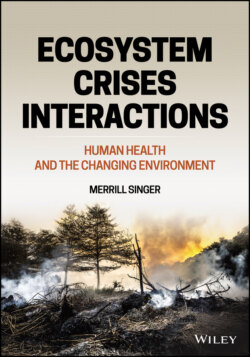Читать книгу Ecosystem Crises Interactions - Merrill Singer - Страница 43
2.3.3 Regional and planet‐wide natural interconnecting structures
ОглавлениеWhile Earth consists of multiple ecosystems, there are other systems that crosscut and connect it, including jet streams and the hydraulic cycle. Jet streams are powerful, fast‐moving rivers of weather‐producing wind that meanders eastward 5–10 miles above the planet in the part of the atmosphere known as the tropopause (Moran 2012; Zimmermann 2013)—the boundary between the troposphere (where planetary weather is formed) and the stratosphere (which is weather‐free). They form in places where large colder and warmer bodies of air meet, as a result of atmospheric heating caused by solar radiation and the rotation of Earth. They move at about 275 miles per hour. Usually, there are two jet streams: a subtropical stream traveling in the Southern Hemisphere that transports atmospheric moisture into storm systems and a more powerful polar‐front stream encircling the Northern Hemisphere. The northern stream varies in its location between polar air from the far north and more temperate air found south of the polar regions. During summer in the Northern Hemisphere, a third stream blows toward the west in tropical high‐altitudes areas. This reverse air stream is associated with the heating of Asia and may play a role in the formation of summer monsoons in the Indian Ocean. It is believed that jet streams were at least partially responsible for the intense drought that caused the Dust Bowl in the U.S. Midwest during the 1930s. Notably, climate scientists hypothesize that the jet streams will gradually as a result of global warming. The current decline in Arctic sea ice, reduced snow cover, and other climate changes are projected to increasingly make the Arctic warm faster than other areas of the planet; indeed, this has already been documented. This change diminishes the temperature gradient that pushes jet stream winds, with important consequences for weather stability and predictability. Such changes will have telling effects on ecosystems across the planet.
The water cycle is the constant movement of water on, in, and above Earth (U.S. Geological Survey 2016). On the planet’s surface, water appears as rivers and streams, ponds, swamps, dew, and oceans, and in frozen form as land and sea ice, all of which are connected through their flows, by precipitation, and by water coursing under the ground in vast quantities in spaces between rocks and subsurface soils and in aquifers. Some precipitation makes its way downward into groundwater. There is also ice found underground in caverns and ice tubes. Fresh water (about half of which is as salty as sea water) is even found in subterranean pools 600 feet under the Atlantic Ocean. Above the planet, the atmosphere is a superhighway of water vapor that moves around the globe. When, during its movement, water vapor encounters cooler temperatures, it condenses to form clouds, which are pushed around by strong winds until the vapor falls to Earth as rain or snow. About 90 percent of the water vapor in the atmosphere is produced by evaporation from water bodies, while the remainder comes from the release of moisture by plants—a process known as transpiration. The oceans are the source of 90 percent of water evaporation that flows into the planetary water cycle. While they are the primary location of water storage on Earth—currently estimated to hold 321 000 000 cubic miles—they vary in volume over time due to climate change, as we see today with rising sea levels due to land ice melt and the increased mobility of molecules in warmer water. Within the oceans, currents like the Gulf Stream move immense amounts of water around the world.
The interconnection of global flows like the jet stream and the water cycle with climate make these systems an important part of the story of the changing ecology on Earth and the development and interface of ecocrises, including loss of biodiversity and climate impact on health.
